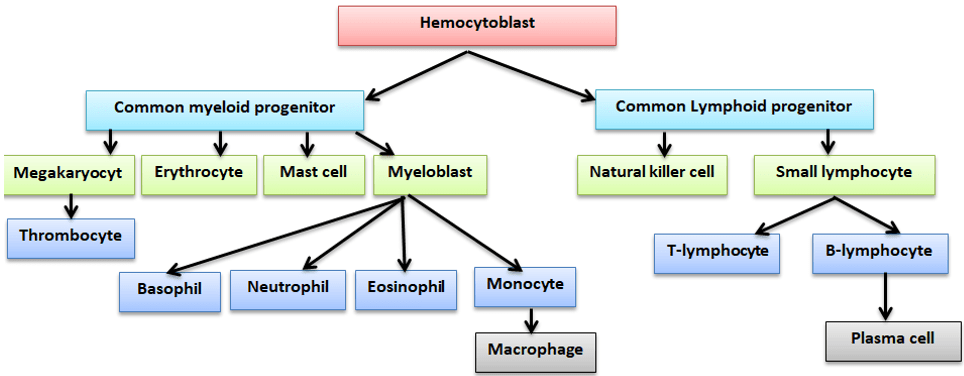This set of Tissue Engineering Multiple Choice Questions & Answers (MCQs) focuses on “Hematopoietic Stem Cells”.
1. Hematopoietic stem cells (HSCs) are the stem cells that give rise to other blood cells.
a) Mesodermal cells
b) Ectodermal cells
c) Endodermal cells
d) Hematopoietic stem cells (HSCs)
View Answer
Explanation: In hematopoiesis, Hematopoietic stem cells (HSCs) are stem cells offering ascent to other platelets.
2. What does the following diagram depict?

a) Hematopoiesis
b) Meiosis
c) Thrombocytosis
d) Hydrolysis
View Answer
Explanation: Hematopoiesis is the procedure by which all full-grown platelets are delivered. In vertebrates, most by far of hematopoiesis happens in the bone marrow and is gotten from a predetermined number of hematopoietic stem cells that are multipotent and fit for broad self-reestablishment.
3. Which of the following are not myeloid cells?
a) Macrophages
b) Monocytes
c) Neutrophils
d) T cells
View Answer
Explanation: Macrophages, Monocyte, and neutrophils are myeloid cells. T cells are a type of lymphoid cells.
4. Hematopoietic stem cells give rise to different types of blood cells, in lines called myeloid and lymphoid.
a) TRUE
b) FALSE
View Answer
Explanation: Hematopoietic stem cells offer ascent to various sorts of platelets, in lines called myeloid and lymphoid. Myeloid and lymphoid genealogies both are engaged with dendritic cell development. Myeloid cells incorporate monocytes, macrophages, neutrophils, basophils, eosinophils, erythrocytes, and megakaryocytes to platelets. Lymphoid cells incorporate T cells, B cells, and characteristic executioner cells.
5. Which of the following are not lymphoid cells?
a) T cells
b) B cells
c) Natural killer cells
d) Megakaryocytes
View Answer
Explanation: T cells, B cells, and Natural killer cells are different types of lymphoid cells. Megakaryocytes are a type of myeloid cells.
6. Hematopoietic stem cells are found in the lungs of adults.
a) TRUE
b) FALSE
View Answer
Explanation: Hematopoietic stem cells are found in the bone marrow of grown-ups, particularly in the pelvis, femur, and sternum. They are likewise found in umbilical cord blood and, in little numbers, in peripheral blood.
7. Hematopoietic stem cells cannot be isolated as a pure population.
a) TRUE
b) FALSE
View Answer
Explanation: Hematopoietic stem cells can’t be disconnected as an unadulterated populace, it is beyond the realm of imagination to expect to recognize them in a microscope. Hematopoietic undifferentiated organisms can be distinguished or disengaged by the utilization of stream cytometry where the blend of a few distinctive cell surface markers (especially CD34) are utilized to isolate the uncommon Hematopoietic undeveloped cells from the encompassing platelets.
8. Hematopoietic stem cells lack the expression of mature blood cell markers.
a) TRUE
b) FALSE
View Answer
Explanation: Hematopoietic stem cells need articulation to develop platelet markers and are in this manner, called Lin. The absence of articulation of ancestry markers is utilized in mix with the location of a few positive cell-surface markers to separate Hematopoietic stem cells.
9. Hematopoietic stem cells, like all adult stem cells, mostly exist in a state of ____________ or reversible growth arrest.
a) Peace
b) Calmness
c) Mindfulness
d) Quiescence
View Answer
Explanation: Hematopoietic stem cells, similar to all grown-up foundational microorganisms, generally exist in a condition of peacefulness, or reversible development capture. The adjusted digestion of quiet HCSs enables the cells to make due for broadened timeframes in the hypoxic bone marrow condition.
10. ____________ strand breaks accumulate in long term Hematopoietic stem cells during aging.
a) DNA
b) RNA
c) Collagen
d) Peptide
View Answer
Explanation: DNA strand breaks collect in long haul Hematopoietic stem cells during aging. This aggregation is related to an expansive weakening of DNA fix and reaction pathways that relies upon HSC peacefulness. Non-homologous end joining (NHEJ) is a pathway that fixes twofold strand breaks in DNA.
Sanfoundry Global Education & Learning Series – Tissue Engineering.
To practice all areas of Tissue Engineering, here is complete set of 1000+ Multiple Choice Questions and Answers.
If you find a mistake in question / option / answer, kindly take a screenshot and email to [email protected]
- Practice Biotechnology MCQs
- Check Biotechnology Books
- Check Tissue Engineering Books
- Apply for Biotechnology Internship
